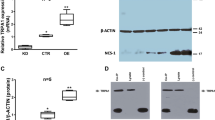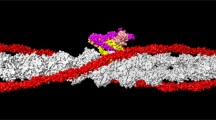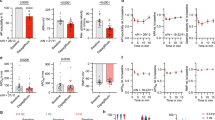Abstract
The aim of the present study was to compare the distribution of ion currents and the major underlying ion channel proteins in canine and human subepicardial (EPI) and midmyocardial (MID) left-ventricular muscle. Ion currents and action potentials were recorded from canine cardiomyocytes derived from the very superficial EPI and central MID regions of the left ventricle. Amplitude, duration and the maximum velocity of depolarization of the action potential were significantly greater in MID than EPI myocytes, whereas phase-1 repolarization was more pronounced in the EPI cells. Amplitudes of the transient outwards K+ current (29.5±1.5 vs. 19.0±2.3 pA/pF at +50 mV) and the slow component of the delayed rectifier K+ current (10.3±2.3 vs. 6.5±1.0 pA/pF at +50 mV) were significantly larger in EPI than in MID myocytes under whole-cell voltage-clamp conditions. The densities of the inwards rectifier K+ current, rapid delayed rectifier K+ current and L-type Ca2+ current were similar in both cell types. Expression of channel proteins in both canine and human ventricular myocardium was determined by Western blotting. In the canine heart, the expression of Kv4.3, Kv1.4, KChIP2 and KvLQT1 was significantly higher, and that of Nav1.5 and MinK much lower, in EPI than in MID. No significant EPI-MID differences were observed in the expression of the other channel proteins studied (Kir2.1, α1C, HERG and MiRP1). Similar results were obtained in human hearts, although the HERG was more abundant in the EPI than in the MID layer. In the canine heart, the EPI-MID differences in ion current densities were proportional to differences in channel protein expression. Except for the density of HERG, the pattern of EPI-MID distribution of ion-channel proteins was identical in canine and human ventricles.






Similar content being viewed by others
References
Akar FG, Wu RC, Deschenes I, Armoundas AA, Piacentino V III, Houser SR, Tomaselli GF (2004) Phenotypic differences in transient outward K+ current of human and canine ventricular myocytes insights into molecular composition of ventricular Ito. Am J Physiol 286:H602–H609
Akar FG, Yan GX, Antzelevitch C, Rosenbaum DS (2002) Unique topographical distribution of M-cells underlies reentrant mechanism of torsade de pointes in the long-QT syndrome. Circulation 105:1247–1253
Baláti B, Varró A, Papp JG (1998) Comparison of the cellular electrophysiological characteristics of canine left ventricular epicardium, M cells, endocardium and Purkinje fibers. Acta Physiol Scand 164:181–190
Bányász T, Magyar J, Körtvély Á, Szigeti Gy, Szigligeti P, Papp Z, Mohácsi A, Kovács L, Nánási PP (2001) Different effects of endothelin-1 on calcium and potassium currents in canine ventricular cells. Naunyn Schmiedeberg’s Arch Pharmacol 363:383–390
Bauer A, Becker R, Karle C, Schreiner KD, Senges JC, Voss F, Kraft P, Kuebler W, Schoels W (2002) Effects of the IKr-blocking agent dofetilide and of the IKs-blocking agent chromanol 293b on regional disparity of left ventricular repolarization in the intact canine heart. J Cardiovasc Pharmacol 39:460–467
Brahmajothi MV, Campbell DL, Rasmusson RL, Morales MJ, Trimmer JS, Nerbonne JM, Strauss HC (1999) Distinct transient outward potassium current (Ito) phenotypes and distribution of fast-inactivating potassium channel alpha subunits in ferret left ventricular myocytes. J Gen Physiol 113:581–600
Bryant SM, Wan X, Shipsey SJ, Hart G (1998) Regional differences in the delayed rectifier current (IKr and IKs) contribute to the differences in action potential duration in basal left ventricular myocytes in guinea-pig. Cardiovasc Res 40:322–331
Cheng J, Kamiya K, Liu W, Tsuji Y, Toyama J, Kodama I (1999) Heterogeneous distribution of the two components of delayed rectifier K+ current: a potential mechanism of the proarrhythmic effects of methanesulfonanilide class III agents. Cardiovasc Res 43:135–147
Dixon JE, Shi W, Wang HS, McDonald C, Yu H, Wymore RS, Cohen IS, McKinnon D (1996) Role of the Kv4.3 K+ channel in ventricular muscle. A Molecular correlate for the transient outward current. Circ Res 79:659–668
Drouin E, Charpentier F, Gauthier C, Laurent K, Le Marec H (1995) Electrophysiologic characteristics of cells spanning the left ventricular wall of human heart: evidence for the presence of M cells. J Am Coll Cardiol 26:185–192
Fedida D, Giles WR (1991) Regional variations in action potentials and transient outward current in myocytes isolated from rabbit left ventricle. J Physiol (Lond) 442:191–209
Furukawa T, Kimura S, Furukawa N, Bassett AL, Myerburg RJ (1992) Potassium rectifier currents differ in myocytes of endocardial and epicardial origin. Circ Res 70:91–103
Gintant GA (1995) Regional differences in IK density in canine left ventricle: role of IKs in electrical inhomogeneity. Am J Physiol 268:H604–H613
Han W, Bao W, Wang Z, Nattel S (2002) Comparison of ion-channel subunit expression in canine cardiac Purkinje fibers in ventricular muscles. Circ Res 91:790–797
Liu DW, Antzelevitch C (1995) Characteristics of the delayed rectifier current (IKr and IKs) in canine ventricular epicardial, midmyocardial, and endocardial myocytes. A weaker IKs contributes to the longer action potential of the M cell. Circ Res 76:351–365
Liu DW, Gintant GA, Antzelevitch C (1993) Ionic bases for electrophysiological distinctions among epicardial, midmyocardial, and endocardial myocytes from the free wall of the canine left ventricle. Circ Res 72:671–687
Nabauer M, Beuckelmann DJ, Uberfuhr P, Steinbeck G (1996) Regional differences in current density and rate-dependent properties of the transient outward current in subepicardial and subendocardial myocytes of human left ventricle. Circulation 93:168–177
Nánási PP, Dankó M, Varró A, Lathrop DA (1992) Nonlinear relationship between Vmax and h-infinity in frog skeletal muscle. Gen Physiol Biophys 11:159–167
Papp H, Czifra G, Lázár J, Boczán J, Gönczi M, Csernoch L, Kovács L, Bíró T (2003) Protein kinase C isozymes regulate proliferation and high cell density-mediated differentiation of HaCaT keratinocytes. Exp Dermatol 12:811–824
Péréon Y, Demolombe S, Baró I, Drouin E, Charpentier F, Escande D (2000) Differential expression of KvLQT1 isoforms across the human ventricular wall. Am J Physiol 278:H1908–H1915
Rosati B, Pan Z, Lypen S, Wang HS, Cohen I, Dixon JE, McKinnon D (2001) Regulation of KChIP2 potassium channel beta subunit gene expression underlies the gradient of transient outward current in canine and human ventricle. J Physiol (Lond) 533:119–125
Sheets MF, Hank DA, Fozzard HA (1988) Nonlinear relation between Vmax and INa in canine cardiac Purkinje cells. Circ Res 63:386–398
Shimizu W, Antzelevitch C (1997) Sodium channel block with mexiletine is effective in reducing dispersion of repolarization and preventing torsade des pointes in LQT2 and LQT3 models of long-QT syndrome. Circulation 96:2038–2047
Sicouri S, Antzelevitch C (1993) Drug-induced afterdepolarizations and triggered activity occur in a discrete subpopulation of ventricular muscle cells (M cells) in canine heart: quinidine and digitalis. J Cardiovasc Electrophysiol 4:48–58
Sicouri S, Antzelevitch C (1995) Electrophysiologic characteristics of M cells in the canine left ventricular wall. J Cardiovasc Electrophysiol 6:591–603
Stankovicova T, Szilard M, Scheerder ID, Sipido KR (2000) M cells and transmural heterogeneity of action potential configuration in myocytes from the left ventricular wall of the pig heart. Cardiovasc Res 45:952–960
Varró A, Baláti B, Iost N, Takács J, Virág L, Lathrop DA, Csaba L, Tálosi L, Papp JG (2000) The role of the delayed rectifier component IKs in dog ventricular muscle and Purkinje fibre repolarization. J Physiol (Lond) 523:67–81
Volders PGA, Stengl M, van Opstal JM, Gerlach U, Spätjens RLHMG, Beekman JDM, Sipido KR, Vos MA (2003) Probing the contribution of IKsto canine ventricular repolarization: key role for β-adrenergic receptor stimulation. Circulation 107:2753–2760
Wettwer E, Amos GJ, Posival H, Ravens U (1994) Transient outward current in human ventricular myocytes of subepicardial and subendocardial origin. Circ Res 75:473–482
Yan GX, Shimizu W, Antzelevitch C (1998) Characteristics and distribution of M-cells in arterially perfused canine left ventricular wedge preparations. Circulation 98:1921–1927
Zygmunt AC, Eddlestone GT, Thomas GP, Nesterenko VV, Antzelevitch C (2001) Larger late sodium conductance in M-cells contributes to electrical heterogeneity in canine ventricle. Am J Physiol 281:H689–H697
Acknowledgements
Financial support for the studies was provided by grants from the Hungarian Research Fund (OTKA-T037332, OTKA-T037334, OTKA-T043182), Hungarian Ministry of Health (ETT-06031/2003, ETT-365/2003, ETT-572/2003) and the National Research and Development Programs (NKFP-1A/0011/2002, NKFP-1A/008/2004).
Author information
Authors and Affiliations
Corresponding author
Rights and permissions
About this article
Cite this article
Szabó, G., Szentandrássy, N., Bíró, T. et al. Asymmetrical distribution of ion channels in canine and human left-ventricular wall: epicardium versus midmyocardium. Pflugers Arch - Eur J Physiol 450, 307–316 (2005). https://doi.org/10.1007/s00424-005-1445-z
Received:
Accepted:
Published:
Issue Date:
DOI: https://doi.org/10.1007/s00424-005-1445-z




